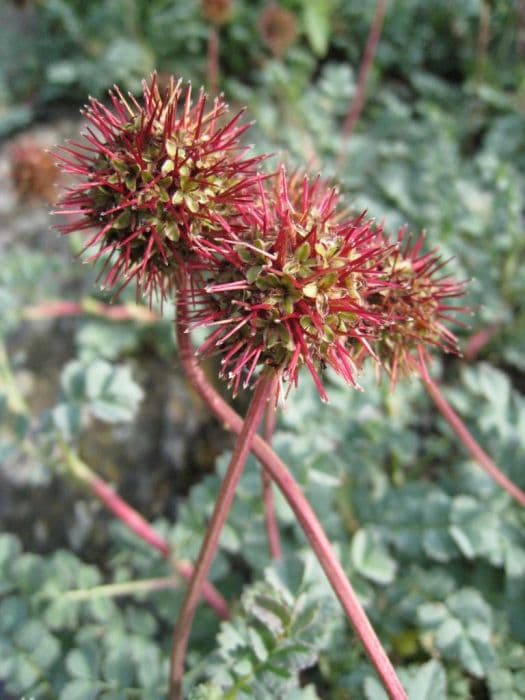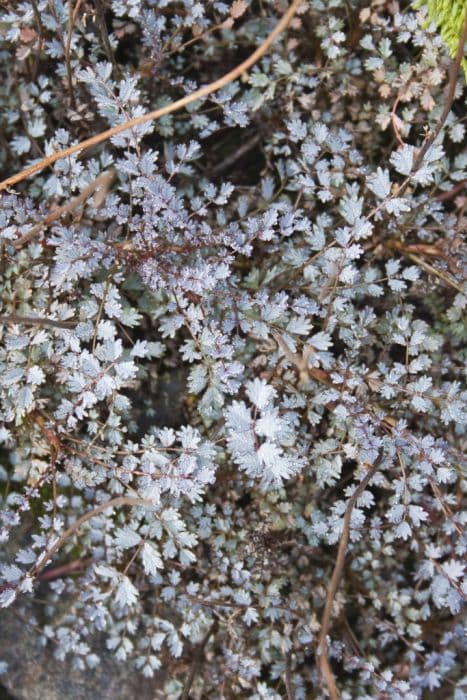Dunwich Rose Rosa 'Dunwich Rose' (SpH)

ABOUT
The Rosa 'Dunwich Rose' is a type of rose plant known for its charming and picturesque blooms. It features an abundance of flowers that possess a classic, cupped shape, presenting a nostalgic appearance that is often sought after by rose enthusiasts. The petals exhibit a soft and velvety texture, which contributes to the plant's romantic aesthetic. The flowers themselves come in a delicate shade of pink that can range from pale to a more pronounced pastel tone, depending on various growing conditions. Each bloom is filled with numerous petals that layer upon one another, giving the flowers a full and lush look. The center of the flowers may be slightly darker or lighter, adding depth and contrast to the overall appearance. This rose plant's foliage consists of a deep, rich green color, providing a striking backdrop for the pink blooms. The leaves are typically glossy, with a leathery quality, and are shaped in a classic rose-leaf fashion—pointed and with a serrated edge. The overall demeanor of the Rosa 'Dunwich Rose' is that of elegance and grace. It exudes a timeless beauty through its traditional rose features and its inviting, soft-hued flowers that can adorn any garden setting, creating an atmosphere of tranquility and charm.
About this plant
 Names
NamesFamily
Rosaceae
Synonyms
Dunwich Rose
Common names
Rosa 'Dunwich Rose' (SpH).
 Toxicity
ToxicityTo humans
The Dunwich Rose is not considered toxic to humans. Although not toxic, ingesting large quantities of rose plants, including the Dunwich Rose, may lead to gastrointestinal discomfort due to the fiber content and natural plant compounds. It's always advisable to avoid consuming any part of ornamental plants.
To pets
The Dunwich Rose is not toxic to pets. As with humans, ingestion of roses is not typically harmful to animals, though eating large amounts of the plant material could potentially cause mild stomach upset due to the fibrous plant matter.
 Characteristics
CharacteristicsLife cycle
Perennials
Foliage type
Deciduous
Color of leaves
Green
Flower color
Pink
Height
3-4 feet (0.9-1.2 meters)
Spread
2-3 feet (0.6-0.9 meters)
Plant type
Shrub
Hardiness zones
5
Native area
Cultivar
Benefits
 General Benefits
General Benefits- Aesthetic Appeal: Rosa 'Dunwich Rose' offers a visually pleasing aesthetic with its delicate and classic rose form.
- Garden Diversity: It can contribute to biodiversity by attracting pollinators like bees and butterflies.
- Fragrance: Provides a natural and pleasant perfume that can enhance the sensory experience of a garden or landscape.
- Landscape Design: Useful for a variety of garden designs, including cottage gardens, rose gardens, and as a border plant.
- Emotional Wellbeing: The presence of flowering plants like Dunwich Rose can contribute to psychological wellbeing and stress reduction.
- Cultural Significance: Roses have a long history of symbolism and are often associated with love and beauty, thus contributing to the cultural depth in a garden.
- Seasonal Interest: Offers seasonal blooms, usually throughout late spring and summer, adding dynamic changes to the garden.
- Wildlife Habitat: Can provide shelter and nesting opportunities for birds when allowed to grow in a more naturalized setting.
 Medical Properties
Medical Properties- This plant is not used for medical purposes.
 Air-purifying Qualities
Air-purifying QualitiesThis plant is not specifically known for air purifying qualities.
 Other Uses
Other Uses- Culinary decoration: Petals of the Rosa 'Dunwich Rose' can be used to embellish desserts and salads for an elegant touch.
- Floral water: Petals can be distilled to create a scented water that is used for fragrancing linens or as a natural room spray.
- Dye source: The petals can be boiled to extract natural dyes for coloring fabrics or paper without the use of chemicals.
- Floral crafts: Petals and buds can be incorporated into potpourri, sachets, or dried floral arrangements for home decor.
- Biodegradable confetti: Dried petals can serve as an eco-friendly confetti alternative for celebrations.
- Creative photography: The roses can be used as a subject or prop in still life photography, enhancing the visual appeal of the photos.
- Homemade rose sugar: Petals can be layered with granulated sugar to infuse it with a subtle rose flavor, perfect for baking or sweetening teas.
- Bath and body: Rose petals can be added to bath bombs or bath salts, providing a gentle fragrance and skin-softening properties.
- Edible rose syrup: The petals can be simmered with sugar and water to create a rose-flavored syrup for use in cocktails or desserts.
- Artisanal papermaking: Incorporating Rosa 'Dunwich Rose' petals into handmade paper can create unique textures and patterns.
Interesting Facts
 Feng Shui
Feng ShuiThe rose is used in Feng Shui practice to enhance love and romance energies, as well as to create a soothing and harmonious atmosphere. It can be placed in the southwest sector of a garden or home to strengthen relationships and encourage feelings of love.
 Zodiac Sign Compitability
Zodiac Sign CompitabilityThe rose is not used in astrology practice.
 Plant Symbolism
Plant Symbolism- Love: As a rose, the 'Dunwich Rose' commonly symbolizes love and romantic affection, often used to express deep emotions and passion.
- Beauty: The rose is often associated with beauty and perfection, with its intricate petals and captivating fragrance, representing the ideal of physical and inner beauty.
- Mystery: The specific epithet 'Dunwich,' potentially referencing a historic or fictional setting, may add an element of mystery or ancient charm to its symbolism.
- Balance: The harmonious structure of roses often leads to its representation of balance and harmony in life or in relationships.
- New Beginnings: Roses are also a symbol for new beginnings and hope, possibly due to their recurrent blooming cycle and resilience.
 Water
WaterThe Dunwich Rose should be watered deeply once every week during its growing season, ensuring that the soil is thoroughly moistened. In hot, dry periods, the frequency may need to increase to twice a week. Whenever watering, it's best to avoid overhead watering to keep the foliage dry and minimize disease risk. Provide the rose with about 1 to 1.5 gallons per watering session to encourage deep root growth, but adjust according to weather conditions and soil drainage.
 Light
LightThe Dunwich Rose thrives in full sun, which means it should receive at least 6 to 8 hours of direct sunlight daily. The ideal spot for this rose is in an area where it's exposed to morning sun, as this helps to dry dew quickly, reducing the risk of disease.
 Temperature
TemperatureThe Dunwich Rose is hardy and can handle a temperature range from around winter lows of 20°F to summer highs around 100°F without significant damage. The ideal growing temperature for the Dunwich Rose is between 65°F and 75°F, which promotes healthy growth and flowering.
 Pruning
PruningPruning the Dunwich Rose is essential to maintain its shape, encourage new growth, and improve air circulation. Prune in late winter or early spring, removing dead or damaged canes, and shaping the plant as desired. It's also beneficial to deadhead spent blooms throughout the growing season to promote further flowering. The best time for a major prune is when the plant is dormant, just before the last frost.
 Cleaning
CleaningAs needed
 Soil
SoilThe best soil mix for a Shrub Rose should be rich, well-draining, and loamy with a pH between 6.0 to 7.0. Incorporate organic matter such as compost or aged manure to enhance fertility.
 Repotting
RepottingShrub Roses typically do not need frequent repotting when planted in the ground, but if grown in containers, repotting every 2 to 3 years is beneficial to refresh the soil and support growth.
 Humidity & Misting
Humidity & MistingShrub Roses prefer outdoor conditions where the natural humidity level is adequate for their growth; they do not require specific humidity modifications.
 Suitable locations
Suitable locationsIndoor
Ensure bright light, proper watering, and good air flow.
Outdoor
Full sun, well-draining soil, and regular watering.
Hardiness zone
5-9 USDA
 Life cycle
Life cycleThe Rosa 'Dunwich Rose' begins its life cycle when a seed germinates, typically in spring, after experiencing a period of stratification that mimics winter chill. The seedling emerges and establishes itself, developing a root system and foliage. As it matures into a young plant, it undergoes vegetative growth, producing stems, leaves, and thorns, and it develops the ability to photosynthesize effectively. Upon reaching maturity, which may take several years, the 'Dunwich Rose' starts the reproductive phase, producing buds that bloom into the characteristic fragrant flowers in late spring to summer, attracting pollinators for sexual reproduction. After pollination, the flowers develop into fruit, commonly known as rose hips, containing seeds that, when mature, fall to the ground or are spread by wildlife to propagate the plant. The plant then enters a period of dormancy during the cold winter months, reducing metabolic activity until conditions are favorable for the next cycle of growth in the spring.
 Propogation
PropogationPropogation time
Spring-Early Summer
Propogation: Rosa 'Dunwich Rose' (SpH) can typically be propagated through a process known as softwood cuttings, with the best time being late spring to early summer when new growth is just beginning to harden or mature. To execute this, one would cut a piece of stem about 6 to 8 inches (15-20 centimeters) long, ensuring that the cutting has a few leaves but removing any flowers or buds to focus the plant's energy on root development. The stem should be sliced just below a leaf node, dipped in rooting hormone to encourage root growth, and then planted in a mixture of half peat and half perlite or another well-draining medium. The cuttings need to be kept well-hydrated in indirect light until roots have developed enough for the plant to be transplanted, which usually takes several weeks. The propagation area should be kept at a consistent temperature - around 70°F (approximately 21°C) - and high humidity conditions can be provided by placing a plastic bag over the cutting and pot setup.









